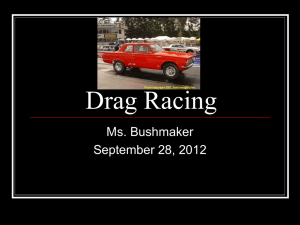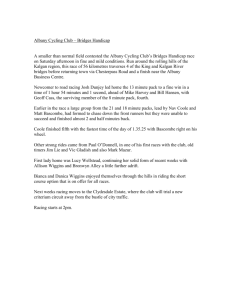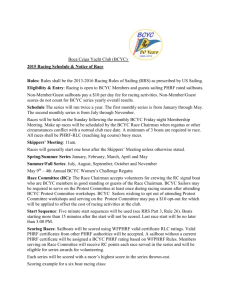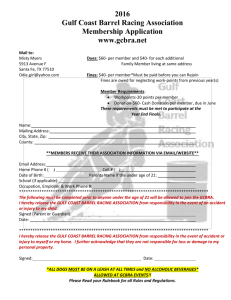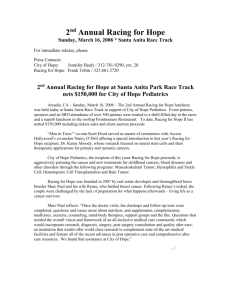A SHORT HISTORY OF H.R.D. AND HIS MACHINES
advertisement
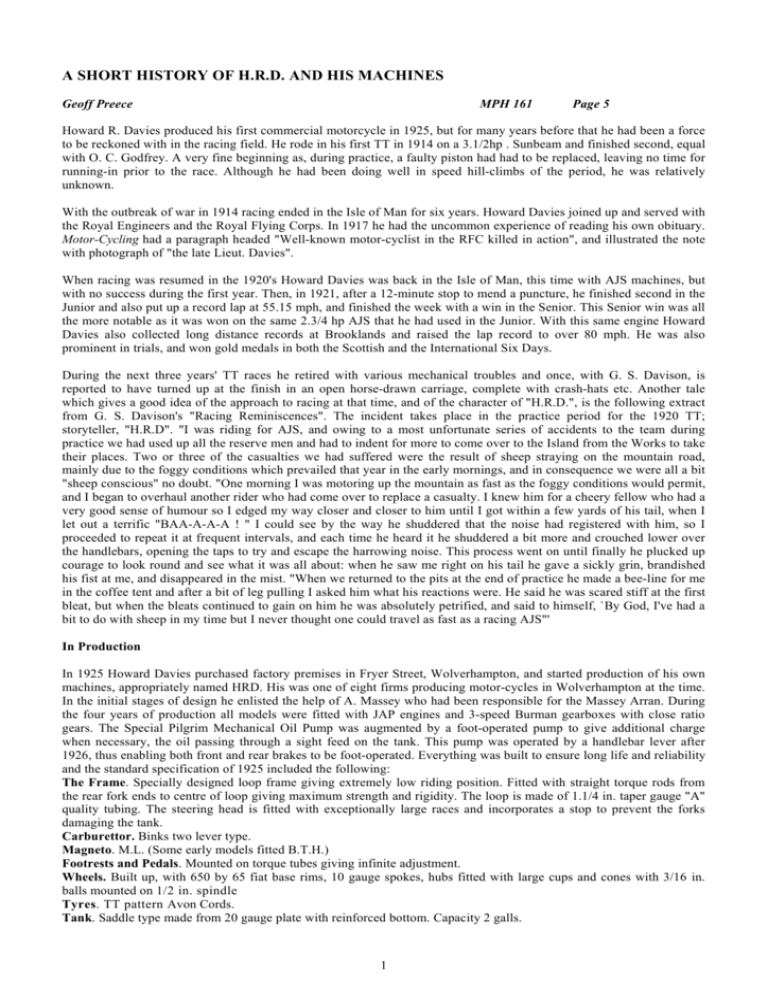
A SHORT HISTORY OF H.R.D. AND HIS MACHINES Geoff Preece MPH 161 Page 5 Howard R. Davies produced his first commercial motorcycle in 1925, but for many years before that he had been a force to be reckoned with in the racing field. He rode in his first TT in 1914 on a 3.1/2hp . Sunbeam and finished second, equal with O. C. Godfrey. A very fine beginning as, during practice, a faulty piston had had to be replaced, leaving no time for running-in prior to the race. Although he had been doing well in speed hill-climbs of the period, he was relatively unknown. With the outbreak of war in 1914 racing ended in the Isle of Man for six years. Howard Davies joined up and served with the Royal Engineers and the Royal Flying Corps. In 1917 he had the uncommon experience of reading his own obituary. Motor-Cycling had a paragraph headed "Well-known motor-cyclist in the RFC killed in action", and illustrated the note with photograph of "the late Lieut. Davies". When racing was resumed in the 1920's Howard Davies was back in the Isle of Man, this time with AJS machines, but with no success during the first year. Then, in 1921, after a 12-minute stop to mend a puncture, he finished second in the Junior and also put up a record lap at 55.15 mph, and finished the week with a win in the Senior. This Senior win was all the more notable as it was won on the same 2.3/4 hp AJS that he had used in the Junior. With this same engine Howard Davies also collected long distance records at Brooklands and raised the lap record to over 80 mph. He was also prominent in trials, and won gold medals in both the Scottish and the International Six Days. During the next three years' TT races he retired with various mechanical troubles and once, with G. S. Davison, is reported to have turned up at the finish in an open horse-drawn carriage, complete with crash-hats etc. Another tale which gives a good idea of the approach to racing at that time, and of the character of "H.R.D.", is the following extract from G. S. Davison's "Racing Reminiscences". The incident takes place in the practice period for the 1920 TT; storyteller, "H.R.D". "I was riding for AJS, and owing to a most unfortunate series of accidents to the team during practice we had used up all the reserve men and had to indent for more to come over to the Island from the Works to take their places. Two or three of the casualties we had suffered were the result of sheep straying on the mountain road, mainly due to the foggy conditions which prevailed that year in the early mornings, and in consequence we were all a bit "sheep conscious" no doubt. "One morning I was motoring up the mountain as fast as the foggy conditions would permit, and I began to overhaul another rider who had come over to replace a casualty. I knew him for a cheery fellow who had a very good sense of humour so I edged my way closer and closer to him until I got within a few yards of his tail, when I let out a terrific "BAA-A-A-A ! " I could see by the way he shuddered that the noise had registered with him, so I proceeded to repeat it at frequent intervals, and each time he heard it he shuddered a bit more and crouched lower over the handlebars, opening the taps to try and escape the harrowing noise. This process went on until finally he plucked up courage to look round and see what it was all about: when he saw me right on his tail he gave a sickly grin, brandished his fist at me, and disappeared in the mist. "When we returned to the pits at the end of practice he made a bee-line for me in the coffee tent and after a bit of leg pulling I asked him what his reactions were. He said he was scared stiff at the first bleat, but when the bleats continued to gain on him he was absolutely petrified, and said to himself, `By God, I've had a bit to do with sheep in my time but I never thought one could travel as fast as a racing AJS"' In Production In 1925 Howard Davies purchased factory premises in Fryer Street, Wolverhampton, and started production of his own machines, appropriately named HRD. His was one of eight firms producing motor-cycles in Wolverhampton at the time. In the initial stages of design he enlisted the help of A. Massey who had been responsible for the Massey Arran. During the four years of production all models were fitted with JAP engines and 3-speed Burman gearboxes with close ratio gears. The Special Pilgrim Mechanical Oil Pump was augmented by a foot-operated pump to give additional charge when necessary, the oil passing through a sight feed on the tank. This pump was operated by a handlebar lever after 1926, thus enabling both front and rear brakes to be foot-operated. Everything was built to ensure long life and reliability and the standard specification of 1925 included the following: The Frame. Specially designed loop frame giving extremely low riding position. Fitted with straight torque rods from the rear fork ends to centre of loop giving maximum strength and rigidity. The loop is made of 1.1/4 in. taper gauge "A" quality tubing. The steering head is fitted with exceptionally large races and incorporates a stop to prevent the forks damaging the tank. Carburettor. Binks two lever type. Magneto. M.L. (Some early models fitted B.T.H.) Footrests and Pedals. Mounted on torque tubes giving infinite adjustment. Wheels. Built up, with 650 by 65 fiat base rims, 10 gauge spokes, hubs fitted with large cups and cones with 3/16 in. balls mounted on 1/2 in. spindle Tyres. TT pattern Avon Cords. Tank. Saddle type made from 20 gauge plate with reinforced bottom. Capacity 2 galls. 1 Forks. Druid or Webb racing type incorporating shock dampers. Four models were produced in the first year, all of which were illustrated in the May issue of MPH. The star of the range was the HD 90. Fitted with a special 500 cc ohv. racing JAP engine, bore and stroke 85.5 x 85, and with a top gear of 4.7 to 1, its road speed was approximately 90 mph. The model designation was an indication of its speed potential. The 1926 range appeared at the Olympia Show in September 1925 and was probably the most impressive show debut any motorcycle firm has ever made. It included a 500 cc winner and so very nearly a Junior winner as well. Although there were many detail changes the only completely new model was the Super 90 2-port 490 cc. This machine embodied all the afterthoughts of the 1925 TTs. The auxiliary oil pump lever was moved to the handlebar so that the 6 in. front brake could be foot operated. The brake pedals and footrests were carried in combined lugs slidable along the torque tubes front to rear. The rear brake drum was ribbed and a steel tube silencer was fitted which combined greater quietness with a pleasanter note. An André steering damper was mounted on the accessory bar with a strap bolted on to the tank top. Dry weight was 281 lb. and the price was 97 gns. The other two 500's were continued and embodied the modifications of the two foot brakes, damper, steel silencer, and a larger, 3 gall petrol tank. The HD 70S cost 66 gns in solo trim, or, complete with sidecar and low gear ratios, 83 gns, Only one 350 was listed-the HD 80. It cost 80 gns; weight 269 lb. All models could be supplied with an Amal carburettor in place of the Binks. A kickstarter was optional on all models. [Amac, at this date, not Amal?Ed.] A really comprehensive range was produced for 1927. Eight models were listed. The previous year's four models were retained and were virtually the same in both details and cost, except that the standard 500 was reduced to 74 gns. Of the new machines, two were 600s. The Super Six Hundred (85.5 x 104 bore and stroke) cost 103 gns. The other 600 was a side-valve which featured a duplex frame. A point of special interest was the method of sidecar fixing, which utilised double lugs to grip both members of the duplex frame, making it impossible for the frame to be pulled out of alignment. Two 350's, an o.h.v. and a s.v., completed the range. The hand-polished enamel produced an immaculate finish, and cards were displayed at the 1926 Show stand stating that all the models were completely standard. The 1928 range consisted of seven models. The top machine was still the Super 90, now featuring the sturdy duplex frame, 7 in. brake drums front and rear with the rear drum ribbed, Webb forks, racing knee grips, a tank-top route-card holder, and twistgrip throttle control. All prices had been reduced. There were three 500's, a two-port fast touring, singleport sports, and a s.v. sports. This machine, at 58 gns, was the cheapest model produced. The 600 s.v. was retained, as were the two 350's - the HD 80 two-port racing, and a standard two-port. Sidecars were available, costing 18 gns. A specially attractive one was the "Launch" sports model. The boat-shaped body was fabric covered having a flat boat-deck forrard with cowl ventilator in the centre and a small flag astern. In Competition HRD's made an impressive racing debut in the 1925 TT. There were two entries in both Junior and Senior races, riders being H. R. Davies and H. F. Harris. In Monday's Junior Howard Davies was second and he won the Senior race on the Wednesday at an average speed of 66.13 mph. On the first lap he lay second, sandwiched between the Nortons of Alec Bennett and Joe Craig. Then on the second lap Bennett faded away and Davies set about increasing his lead, to finish over three minutes ahead of second man, Frank Longman. Geoff Davison asked H.R.D. what sort of a run he had had. "My machine ran perfectly", he replied, "and I had no trouble at all. The course, incidentally, was very much improved between '24 and '25; a lot of work had been done on the mountain stretch. The surface was tarred almost all the way round and there was a notable absence of stones. These improvements were reflected in the speeds of the races. My winning average in the Senior was 4.1/2 miles faster than the previous year, whilst my speed as second in the Junior was over seven miles an hour faster than the 1924 race." In these races H.R.D. was helped in the preparation of the machines by that wizard of tune, Hubert Le Vack. There were eight Senior and three Junior entries for the 1926 races, but no success. 1927 saw three Senior and two Junior HRD's on the line. In the Junior F. W. Dixon piloted an HRD to win at an average speed of 67.19 mph. This was the last success in the Island for HRD's and only a lone 350 was entered for the 1928 races. Out of 18 starters in the Manx Amateur Road Races from 1926 to 1933 there were 9 finishers, with a second place in the 1926 race by M. 1. Dawson. This was the highest placing attained. Howard Davies did very little racing outside the Isle of Man, leaving other events to be supported by a band of enthusiastic amateurs. Prominent among these was L. Dallimore, who put up some stirring performances at the Greenford dirt-track on a 344 cc machine. In Conclusion 2 Then, in 1929, a certain Cambridge undergraduate bought the firm, transferred the factory to Stevenage, added the prefix "Vincent", and went on to make the name Vincent-HRD one of the most respected in the world of motorcycling. Although there are no records of the number of machines produced by HRD it is put, by a reliable authority, at around the thousand mark. Of these, only a handful appear to be still with us. In MPH 133 George Spence was after details for his HD Super 90 and in MPH 139 there was an HD 80 for sale. F. P. Heath (racing secretary of the VMCC) has one complete, less engine, and there is the HD 70S which appeared at last year's VOC Rally. In the Motor-Cycle of April 12, 1928, appeared the following advertisement which no doubt sent many riders hot-foot to King's showroom in Oxford: Speedmen Look! Read! Unrepeatable offers: Two-port TT HRD, special engine, hand and foot gear change, special carbs, big brakes, racing Cord tyres-Flexitas tubing throughout, large capacity tank, cost over £150 to produce, capable 96 mph, terrific acceleration, gorgeous condition throughout-70 gns. Also rest of the 5 Team Machines, including 350 cc model similar to above and a stripped sprint model, at various prices. These machines will only be sold to good hardened riders who can do them full justice. King's, Oxford. Only two VOC Members own to having ridden HRD's in their day: our President, and Vice-President Bill Hindes. Bill says that his HD 90 would cruise all day at 80 mph. but when run at maximum speed would -eat out rockers at an alarming rate. 3
